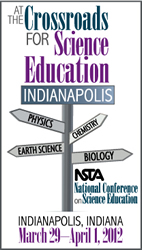 Make NASA a part of your National Science Teachers Association, or NSTA, experience this year! The 2012 NSTA’s national conference is being held March 29 – April 1, 2012, in Indianapolis, Ind. Dozens of NASA presentations, workshops and short courses are scheduled during the conference. To find NASA sessions that fit into your schedule, visit http://bit.ly/nsta2012.
Make NASA a part of your National Science Teachers Association, or NSTA, experience this year! The 2012 NSTA’s national conference is being held March 29 – April 1, 2012, in Indianapolis, Ind. Dozens of NASA presentations, workshops and short courses are scheduled during the conference. To find NASA sessions that fit into your schedule, visit http://bit.ly/nsta2012.
Also, stop by the NASA exhibit booth (#2159) to learn about exciting new NASA programs and products. NASA Explorer Schools, or NES, representatives will be there to share information and answer your questions.
If you are not yet a participant in the NES project, you can obtain detailed information about NES by visiting the NASA exhibit booth or attending a NES presentation. The session, “Teach STEM? NASA Explorer Schools Can Help!”, takes place on Fri., March 30, from 11 a.m. – noon in the Cabinet Room of the Westin Indianapolis.
Everyone is invited to attend any of the additional NES lesson-related sessions:
• Virtual Lab and NASA Explorer Schools on Friday, March 30 from 4 – 4 45 p.m. in room 142 of the Convention Center.
• The “NASA Engineering Design Challenge: Spacecraft Structures” session takes place on Sat., March 31, from 9:30 – 10:30 a.m., in room 111/112 of the Convention Center.
Attend these presentations and see how NES helps teachers by packaging everything needed to deliver an exciting NASA-related lesson to students!


 NASA is seeking formal and informal education organizations, individually or working together, to host a live, in-flight education downlink during Expeditions 33 and 34 (approximately September 2012 to March 2013). To maximize these downlink opportunities, NASA is looking for organizations that will draw large numbers of participants and integrate the downlink into a well-developed education plan. The deadline to submit a proposal is June 1, 2012.
NASA is seeking formal and informal education organizations, individually or working together, to host a live, in-flight education downlink during Expeditions 33 and 34 (approximately September 2012 to March 2013). To maximize these downlink opportunities, NASA is looking for organizations that will draw large numbers of participants and integrate the downlink into a well-developed education plan. The deadline to submit a proposal is June 1, 2012.
 Sandeep Yayathi works on Robonaut, a dexterous humanoid robot built and designed at NASA’s Johnson Space Center in Houston. On April 4, 2012, from noon – 1 p.m. EDT, Yayathi will answer student questions about his work with Robonaut, his career path and what the future holds for robotics. Robonaut 2, or R2, launched to the International Space Station on space shuttle Discovery as part of the STS-133 mission. It is the first dexterous humanoid robot in space and the first U.S.-built robot at the space station.
Sandeep Yayathi works on Robonaut, a dexterous humanoid robot built and designed at NASA’s Johnson Space Center in Houston. On April 4, 2012, from noon – 1 p.m. EDT, Yayathi will answer student questions about his work with Robonaut, his career path and what the future holds for robotics. Robonaut 2, or R2, launched to the International Space Station on space shuttle Discovery as part of the STS-133 mission. It is the first dexterous humanoid robot in space and the first U.S.-built robot at the space station. Pythagorean Theorem: Exploring Space Through Math — Lunar Rover Web Seminar
Pythagorean Theorem: Exploring Space Through Math — Lunar Rover Web Seminar Make NASA a part of your National Science Teachers Association, or NSTA, experience this year! The
Make NASA a part of your National Science Teachers Association, or NSTA, experience this year! The